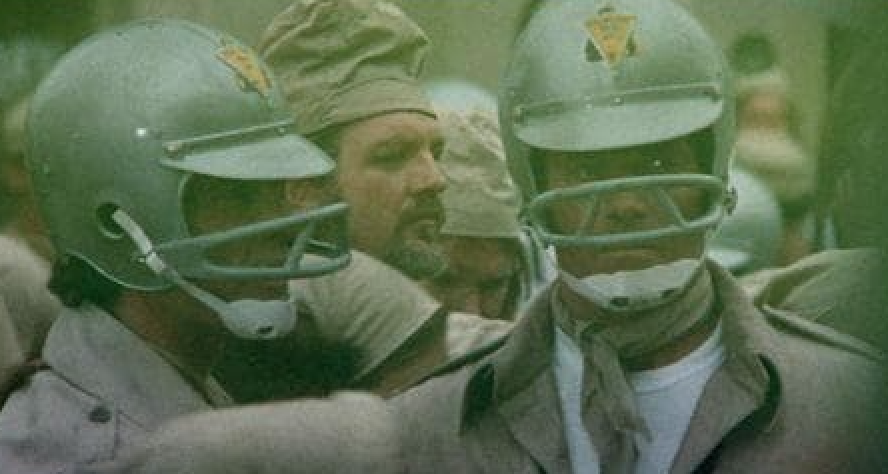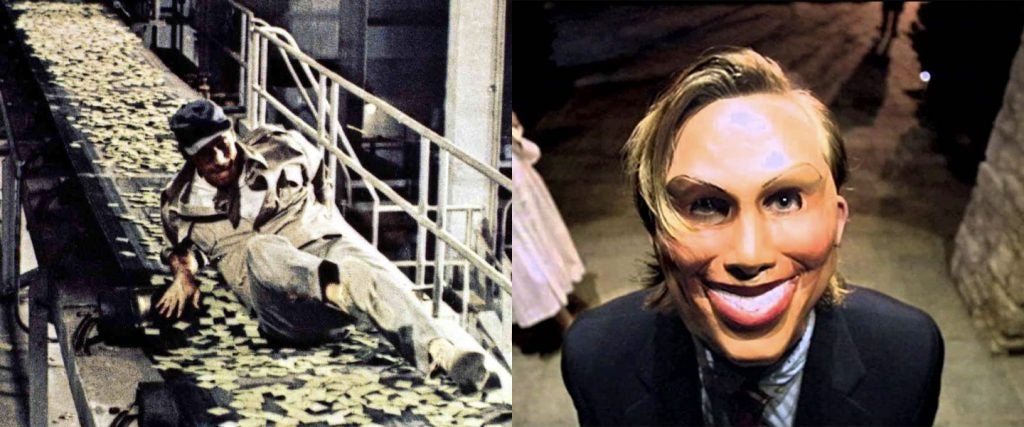It’s always amusing when a movie that takes place in “the future” lets us know exactly when it’s set. In 1982, Blade Runner came out, with an opening title card informing the viewer that it was November 2019. Such specificity gives these films a concreteness — we can calculate just how far ahead in time it is from us — but it also encourages eagle-eyed cineastes to keep that magic date in the back of their head, ready to alert the rest of us when that fateful day in the future is, suddenly, right now.
The same thing happened at the start of the New Year, with several friends pointing out that certain “futuristic” movies took place in 2022. The two most cited were Soylent Green, a 1973 sci-fi thriller starring Charlton Heston as Thorn, a detective trying to figure out who killed a top man at the Soylent Corporation and why. The other was more recent: 2013’s The Purge, in which Ethan Hawke tries to protect his wife and kids from a group of killers on the one night a year in America where all crime, including murder, is legal. (By the way, shout out to the peeps just doing white-collar crimes during the Purge, like tax evasion, while everyone else is straight-up killing people.)
Both films dare to suggest a possible, albeit exaggerated vision of what 2022 was going to be like. Similar to other dystopian films, Soylent Green and The Purge are meant to be bleak warnings about the worst aspects of society, and how they could grow to become exponentially more awful if left unchecked.
So which portrait of 2022 is more despairing? And which one ended up being more right? Let’s break it down, taking into account several different societal cancers that are on display.
How’s the Environment Doing?
Soylent Green: Pretty terrible! One of the most chilling aspects of the film are its opening titles, which through an eerie time-lap montage shows a seemingly idyllic world changed over the decades, destroyed by overpopulation, rampant industrialization and poor stewardship of the planet. By the montage’s end, we’re in the “present,” where New York has become an overcrowded hellscape.
Soylent Green potently tapped into contemporary fears of what could happen if Americans didn’t do a better job caring for the environment. “1973 was not too long after the founding of the Environmental Protection Agency and the signing of the Clean Air Act,” Dr. Andrew Bell, who teaches Environmental Studies at New York University, told Science & Film, “so urban pollution was visible in a way it isn’t now.” Indeed, the movie’s exterior shots look hazy and corroded — you can practically feel the toxic air filling the characters’ diseased lungs.
The Purge: We don’t get much of a sense of how the planet’s doing environmentally. I mean, things are bad in general, but you could argue that global warming is less of a concern than, say, a full 12 hours a year when you could be murdered with impunity.
Any Improvement on Economic Inequality?
Soylent Green: The 1970s were when Americans started noticing a profound gap between the rich and poor, with the wealthiest continuing to experience income growth, but middle- and lower-class households stagnating. In director Richard Fleischer’s film, this plays out in a New York where the rich live in heavily guarded luxury apartments, insulated from the starving masses. They’re practically untouchable — unless, of course, you’re William R. Simonson (Joseph Cotten), one of the heads of Soylent, who’s been murdered, setting the plot in motion.
The Purge: There’s a pretty strong eat-the-rich vibe coursing through the film, which follows James Sandin (Ethan Hawke) and his well-to-do family as they stay locked up in their fancy house, waiting for the Purge to be over. But their night goes pear-shaped once James is confronted by a sinister gag of sharply dressed thugs wanting to kill the homeless man James’s son Charlie (Max Burkholder) brings inside their fortified, super-secure home. (By the way, that security system? James’ company developed it, getting rich selling peace of mind to Purge-scared Americans.)
“The first [Purge film] was always this morality play,” writer-director James DeMonaco said in 2018. “We wanted to focus on that One Percent.” James thinks his money and influence can protect him from this gang, who enjoy brutalizing the poor during the Purge for sport. Whether it’s the gang’s cruelty or James’ exploitation of Americans’ fears, the film is a twisted extrapolation of the way the privileged prey on the less fortunate.
How Are Women Treated?
Soylent Green: Many people have noticed that Shirl (portrayed by Leigh Taylor-Young) looks a lot like Lana Del Rey. In the film, Shirl is the “furniture,” women who are essentially indentured servants to the rich. (They’re nicknamed “furniture” because they come with the apartment.) It’s a concubine-like relationship as she caters to Simonson, later falling for Heston’s manly detective. You could argue that Taylor-Young playing such a vacuous character is sexist, but it’s also part of the movie’s point that, in a dystopian, oligarchical society, women are often reduced to second-class status. Regardless, it’s hard to know who has it worse in Soylent Green: the poor women starving in the streets, or the furniture who must submit to their wealthy master’s sexual urges.
The Purge: The film’s central female character is James’ wife Mary (Lena Headey), who eventually will need to rise up to protect her family. And although it’s a bit patronizing, The Purge suggests that while everyone will have to fight for themselves in this future world, women will be the ones who can save us — even if that means kicking a lot of ass. “I have my methods as an actor,” Headey said, “so I went to the place of ‘If somebody came near my children, with bad intent?’ It’s a feeling without a lid, of what you would do, physically, verbally, to protect the one thing that is your greatest love.”
Mary is the one speck of goodness in what appears to be a pretty immoral, miserable reality. After all, she’s a mom.
What’s Happening With Law Enforcement?
Soylent Green: Are the protesters becoming too unruly on the streets because they’re starving? No problem, the cops will just send a big bulldozer to indiscriminately sweep them up like they’re garbage. (“The scoops are on their way!”) Weirdly, though, the riot police in Soylent Green wear football helmets, which seems neither that menacing nor a good way to protect yourself.

The Purge: During those murderous 12 hours, it’s anything goes. (You can’t kill politicians, though.) In the film’s reality, the Purge has been so successful that crime is basically nonexistent in America now. I’m not sure if I buy that premise, though: Would people really be storing up all their desires to get revenge until a year later for the next Purge? (Lots of people now try to kill folks, assuming that they won’t get caught.) Regardless, in the sequel The Purge: Anarchy, we learn that the ultra-conservative government has created death squads to wipe out wide swaths of the poor during those 12 hours — which suggests that law enforcement uses the Purge to ratchet up the systematic targeting of poorer communities that we already see in our world.
What’s the State of Overacting Like?
Soylent Green: Charlton Heston hasn’t met scenery he doesn’t enjoy chewing, and in Soylent Green, he really has a ball. (I know, I know, you’re waiting for me to show you The Scene — don’t worry, I’ll get to it in a second.)
The Purge: For a B-movie horror flick, The Purge is pretty restrained in its acting. But that doesn’t stop the leader of the murderous gang, played by Rhys Wakefield, from being a very persuasive, devil-grinned, Aryan-looking killer. “I enjoy dark characters,” Wakefield said later. “You have to find a sense of empathy with those characters. He’s just a well-dressed psychopath who just wants to Purge.”
Anything Good to Eat?
Soylent Green: Okay, you’ve been patient enough, here you go…
In the film, the food supply (at least for the non-rich) has become so degraded that people subsist on Soylent, supposedly made from plankton. Of course, we’ll eventually discover that that’s not actually the main ingredient, but for all of Heston’s bombastic acting in that final scene, it remains a darkly chilling idea that, at some point in the future, we may have to resort to eating discarded humans in order to survive.
Perhaps even more upsetting was that, nearly 10 years ago, an actual meat-alternative company was unveiled named Soylent. (“[T]he name Soylent is really good for encouraging further discussion and thought,” Soylent creator Rob Rhinehart said in 2013 when explaining why he’d want to align his product with a dystopian 1970s film. “Clearly, I’m wanting someone to investigate it a little deeper if I’m calling it Soylent. It doesn’t seem very marketable!”) Thankfully, no matter how bad a global food shortage would get, it seems unlikely that eating people would ever be a reasonable solution. Honestly, we’d probably be too busy trying to kill each other for such a ghoulish scenario to be realistic. Good news!
The Purge: James’ family’s meal looks kinda delicious.
What’s the Movie’s Main Takeaway?
Soylent Green: Everything is awful, our corporations are lying to us, our police force protects the powerful and the planet has been despoiled beyond all measure. Also, check the label to see exactly what it is that you’re putting in your body.
The Purge: Violence is addictive and really, really bad. DeMonaco got the idea for the film from his wife, who was nearly killed in a road-rage incident. “[S]he’s a nice person, I hope this doesn’t reflect poorly on her,” he recalled, “but she said something like, ‘I wish I had one a year,’ meaning one legal murder. It was a moment of anger, but the idea of one legal murder a year stayed with me.”
DeMonaco, who has a fear of guns, decided to explore what would happen if killing was legal, figuring it would be a low-budget horror film that never found a mainstream audience. The fact that The Purge was a hit, spawning a franchise, has left him a little uneasy because some people think he intended to celebrate violence or advocate for his wife’s dark suggestion. “To me, [the Purge is] one of the most grotesque concepts of all time,” he insisted. “So anyone who takes it as some kind of sick wish or glorification of violence… it’s the opposite intention from the filmmakers.”
Just How Depressingly Accurate Is the Movie?
Soylent Green: Because of Heston’s volcanic “Soylent Green is people!” line reading, the movie has risked being thought of as a campy joke. But its pessimistic vision of 2022 is actually fairly spot-on — not bad for a 50-year-old film. You can chuckle at the badly dated outfits and some of the hokey dialogue, but even though 2022 isn’t as terrible as what Soylent Green predicted, it’s depressing that it’s not more off-base.
The Purge: The most dispiriting thing about The Purge is that it’s actually not very good. (Also, I’m sorry, but one thing I never understood: Why would you hang out with anyone during that 12-hour period? Lock yourself in your bedroom, people!) The logistics of the Purge don’t make a ton of sense, but DeMonaco’s underlying notion of our need to get vengeance on others is scarily accurate. The movie is too clumsy in its execution, mostly turning into one more home-invasion thriller, but the series’ popularity suggests that a lot of us wouldn’t mind living vicariously through other people’s bloodlust and frantic desire to stay alive. The Purge may not work, but that it strikes a chord with so many ought to leave us all a little on edge.

